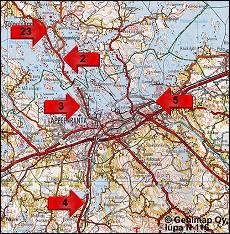
|
|
Site map: Sites 2-5
|
1. Sailing barriers in the Rannuusinsalmi Strait in Suomenniemi
Two sailing barriers lie beneath the water in the Rannuusinsalmi Strait. They consist of rows of timber caissons filled with stones. The barriers form level dam-like structures on the bottom of the strait, some 1-1.5 metres below the surface, depending on the water level.
Constructing the barriers rendered the Rannuusinsalmi Strait unnavigable for large vessels. The barriers were built on the bottom of the strait at deeper points where passage would have been possible. They consist of a total of twelve large, rectangular, stone-filled timber caissons, each about 7.5 x 3-3.5 metres in size. The construction site had to be very large, because a total of at least 150 pieces of timber and 170 cubic metres of filler stones were needed.The barriers may have been built when the water was low, but it is more likely that they were made on the ice in the winter. Probably the caissons were assembled on top of the ice, a hole was sawn in the ice, and the caissons were dropped down to the bottom.
The barriers may have been built by the Swedes in 1789. If so, the barriers would be related to the Russian-Swedish war of 1788-1790, when King Gustavus III tried to expand Sweden-Finland by taking areas from Empress Catherine II of Russia. At the time, the border between Sweden and Russia ran right beside the Rannuusinsalmi Strait.
Location: The barriers are located in the Rannuusinsalmi Strait, in the Saimaa lake system, between lakes Ieselkä and Liittokivenselkä and between the islands Olkisalonsaari and Hämeensaari. Accessible by boat. The sailing barriers are visible when the surface of Lake Saimaa is lower than usual.
